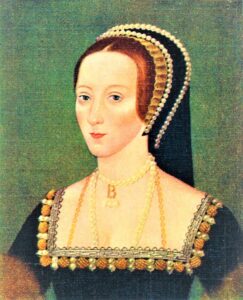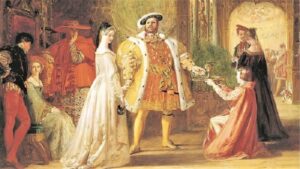Anne Boleyn (Born on 1501-7? in Norfolk or Kent—Died on May 19, 1536, in London, England) was the Queen of England from 1533 to 1536 as the second wife of King Henry VIII. She is the mother of Queen Elizabeth I. Her date of birth used to be set to 1507, but most modern historians date it to 1501.
Her marriage to Henry VIII set off the complex, and often a tragic, political and religious change of the English Reformation movement. Anna Bolena is arrested on May 2, 1536, she was accused of adultery, incest, and high treason, she was executed by beheading on May 19, 1536.
It is now generally accepted that she was innocent of these charges. Anne Boleyn was later celebrated as a martyr in a Protestant culture, particularly in the work of John Foxe.
Her life has been adapted into numerous novels, plays, songs, operas, television dramas, and movies, including Anne of a Thousand Days, The Other Boleyn Girl, The Tudors, The Six Wives of Henry VIII, and Doomed Queen Anne.

Quick Facts Of Anne Boleyn
- Born: AC. July 1501–1507, in Blickling Hall, Norfolk or Hever Castle, Kent
- Died: 19 May 1536, Tower of London, London, United Kingdom
- Also Known As: Queen of England
- Tenure: 28 May 1533 – 17 May 1536
- Coronation: 1st June 1533, in Westminster Abbey
- Predecessor: Catherine of Aragon
- Successor: Joan Seymour
- Spouse: Henry VIII (m. 1533; ann. 1536)
- Children: Elizabeth I of England
- Family: Boleyn
- Religion: Catholicism then Anglicanism
- Parents: Father – Thomas Boleyn, 1st Earl of Wiltshire, Mother – Elizabeth Boleyn, Countess of Wiltshire
- Burial: 19 May 1536, Church of St Peter ad Vincula, Tower of London, London
Early Life Of Anne Boleyn
Anna Boleyn was the second daughter of Thomas Boleyn, 1st Earl of Wiltshire, and Elizabeth Boleyn, Countess of Wiltshire. Thomas Boleyn was a gifted diplomat who spoke several foreign languages, which allowed him to gain the favor of King Henry VII of England, who sent him on several diplomatic missions abroad.
Elizabeth Boleyn descended from an old aristocratic family, was in the retinue of two queens, Elizabeth of York and Catherine of Aragon. Boleyn lived in his family estate Blickling Hall, Norfolk (East of England) to 15 miles (24 km) from Norwich.
By the time of Anna’s birth, the Boleyn family was considered one of the most respected among the English nobility. According to many historians, it certainly was a much more noble birth than Jane Seymour, Catherine Howard, and Catherine Parr, the other three wives of Henry VIII of British women.
Anna was raised at Hever Castle in Kent with her siblings Maria Boleyn and Jerzy Boleyn. Her primary education was typical of the women of her class. In 1512, Thomas Boleyn, on behalf of Henry VII, went on a diplomatic mission to Brussels.
He made a favorable impression on the regent Margaret of Austria, daughter of Maximilian I, the emperor of the Holy Roman Empire, and she did not refuse his request to accept his daughter Anna into her retinue.
In 1513, Anna arrived at the Margaret of Valois, and she, despite her young age (at that time under 12 years old), was fascinated by the talents of la petite Boulain… Her further studies included arithmetic, family genealogy, grammar, history, reading, spelling, as well as household management, handicrafts, foreign language lessons, dance, singing, music, and good manners.
Like any girl from a noble family, she learned horseback riding, archery, hunting, playing cards, chess, and dice.
Wedding with King Henry VIII
On September 1, 1532, the title of Marquis of Pembroke was created in Anne Boleyn’s honor, making Anna the richest woman in the kingdom. The Bolena family also obtained numerous privileges from the relationship with the English king: her father Thomas Boleyn, former viscount of Rochford, became Earl of Wiltshire, while his Irish cousin James Butler became Earl of Ormond.
In addition, thanks to Anna’s intervention, Sister Maria received an annual pension of 100 pounds, while the younger son of the latter, Enrico Carey, was educated in a prestigious Cistercian monastery. In October 1532, King Henry VIII and Anna went to Calais to attend the meeting with the French King Francis I, obtaining his approval for the wedding.
Immediately after their return to Dover, the two were married in a secret ceremony and the first week of December 1532 Anne Boleyn discovered she was pregnant, making the king confident of finally having the much-desired male heir.
So, knowing that the secret wedding ceremony was not legally valid and not being able to wait any longer for the verdict of the trial, Henry VIII had a new law passed that would allow the two to legally marry under the law of the new English Church.
On January 25, 1533, King Henry married Anna in London, in a second wedding ceremony. Also in this case certain confidentiality and secrecy were maintained, to the point that to date the exact place where the wedding was celebrated is not known, probably in the Palace of Whitehall (and more precisely in the Queen’s Study) or in the Palace of Westminster.
However, the marriage was not made public until April, shortly before Anna’s coronation as Queen of England.
On May 23, 1533, the Archbishop of Canterbury Thomas Cranmer, in an audience of the Special Court of the Priory of Dunstable (in Bedfordshire), concluded the process (although he did not have the authority, since the final decision rested with the pope) declaring, and therefore null, the marriage between Caterina and Enrico; on the other hand, five days later – May 28, 1533 – Cranmer declared the marriage between King Henry and Anne Boleyn valid.
Following this decision, Catherine of Aragon decided to appeal to Rome. To avoid further obstacles, King Henry VIII had a new law passed which made matters concerning England the exclusive competence of the English courts (thus preventing any foreign interference, especially the Holy See).
Life as Queen Of England

Anna had a larger staff of servants than Catalina’s: there were more than 250 servants to attend to her personal needs, from priests to stable boys. There were also more than 60 bridesmaids who served her and accompanied her to social events.
He also employed several priests who acted as his confessors, chaplains, and religious advisers. One was the religious moderate Matthew Parker, who became one of the main architects of the modern Church of England in the reign of his daughter Elizabeth I.
Her reputation as a religious reformer spread throughout Europe, and she was hailed as a heroine by Protestant figures; even Martin Luther saw his accession to the throne as a good sign. He also saved the life of the French reformist Nicolas Bourbon, who was sentenced to death by the French Inquisition.
He appealed to the French royal family, who saved Bourbon’s life as a favor to the English queen. Bourbon would later refer to her as “the queen that God loves.” Although he advocated religious reform, especially by translating the Bible into English, he did not challenge the Catholic doctrine of transubstantiation.
